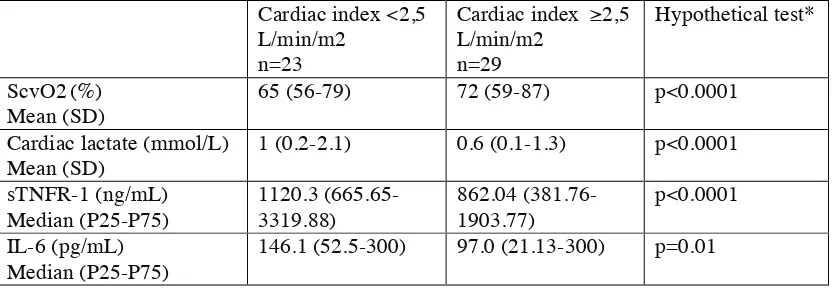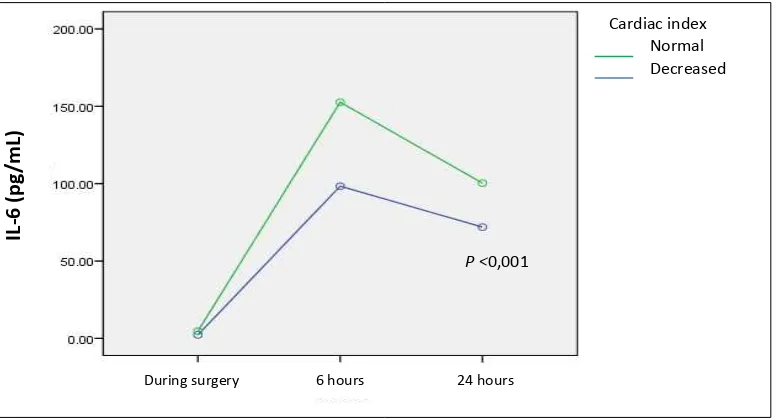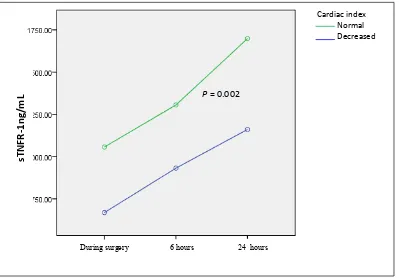Crit Care Shock (2016) 19:14-20
Superior cava vein saturation and cardiac lactate as cardiac output
predictor after cardio-pulmonary bypass on children
Dyah Kanya Wati, Sudigdo Sastroasmoro, Amir Madjid, Siti Boedina, Mulyadi M. Djer, Hendra
Santoso
Abstract
Objective: to evaluate cardiac heart lactate, su-perior cava vein saturation and microcircula-tion dysfuncmicrocircula-tion as cardiac output predictors after surgery on patients with Tetralogy of Fal-lot (TF) through measuring serum level of sTNFR-1 and IL-6.
Design: cohort study
Setting: Cipto Mangunkusumo Hospital
Patient and participants: Subjects were children aged 1 to 6 years that underwent corrective surgery. Subjects who met the inclusion criteria were divided into 2 groups after ischemia-reperfusion injury (post surgery). The first group was subjects with high cardiac lactate and the second group was subjects with low cardiac lactate.
Measurements and results: Subjects were ob-served for 24 hours; during surgery, 6 and 24 hours after aortic clamp removed.
During July 2012 - December 2013, there were 52 patients who became subjects. There were proportion differences between cardiac lactate and cardiac output change after cardiac sur-gery. Increase of cardiac lactate has a correla-tion with increasing levels of sTNFR-1 and IL-6 and decreasing index of Tc, ScvO2 and cardiac output. There were correlations among low in-dex of ScvO2, high inin-dex of cardiac lactate and decrease of cardiac output. High sTNFR-1 and IL-6 were correlated to low cardiac output. Cardiac lactate, ScvO2 and MAP can be used as predictors of cardiac output change in patients with cardio-pulmonary bypass. sTNFR-1 and IL-6 levels were correlated with cardiac output changes after cardiac surgery.
Conclusion: Cardiac lactate and ScvO2 are
val-uable in measuring cardiac output changes on patient with cardio-pulmonary bypass.
Key words: Cardio-pulmonary bypass, IL-6, cardiac lactate, ScvO2, sTNFR-1, tetralogy of Fallot.
Address for correspondence: Dr. Dyah Kanya Wati, MD
Pediatric Consultant, Critical Care Medicine Udayana University, Sanglah Hospital Pulau Nias Street, Denpasar 80114, Indonesia Tel: +62-361-246211
Fax: +62-361-244038
Email: dyahpediatric@yahoo.com
From Pediatric Department, Faculty of Medicine, Udayana University, Sanglah Hospital, Bali, Indonesia (Dyah Kanya Wati and Hendra Santoso), Pediatric Department, Faculty of Medicine, University of Indonesia, Cipto Mangunkusumo Hospital, Jakarta, Indonesia (Sudigdo Sastroasmoro and Mul-yadi M. Djer), Anesthesiology Department, Faculty of Medi-cine, University of Indonesia, Cipto Mangunkusumo Hospital, Jakarta, Indonesia (Amir Madjid), Clinical Pathology Depart-ment, Faculty of Medicine, University of Indonesia, Cipto Mangunkusumo Hospital, Jakarta, Indonesia (Siti Boedina). Introduction
Tetralogy of Fallot (TF) is the most common cyanotic congenital heart disease (CHD) in chil-dren that require corrective surgery as definitive therapy. (1) Corrective surgery is performed by using the cardio-pulmonary bypass machine (CBM) that put patients on ischemia-reperfusion .
injury risk. (2)
Low cardiac output, in turn, can cause microcir-culation failure. (8) Microcirmicrocir-culation failure that persists in 24 hours will lead to pathogenic cascade activation that can end as organ failure. Monitoring becomes important at the level of microcirculation, oxygen delivery, and tissue oxygenation levels. (9,10)
This study used transcutaneous CO2 monitoring to monitor dysfunction that occurs at the level of microcirculation and ScvO2 that continuously monitor oxygen delivery and tissue oxygenation levels. (11) Microcirculation dysfunction and ScvO2 monitoring are very helpful in evaluating postoperative interventions and also able to predict decrease of cardiac output in the normal hemody-namic condition after surgery. (12,13) This study aimed to answer challenges of monitoring cardiac output performance after the surgery. As far as we know this was the first study that evaluated cardiac lactate and ScvO2 levels to predict microcircu-lation dysfunction after cardiac correction surgery in children.
Materials and methods
This was a cohort study on patients with TF aged 1 to 6 years that underwent an open surgery at Cipto Mangunkusumo Hospital. The study was conduct-ed in three phases, the first phase was a cross-sectional study, phase II was a cohort study, and phase III was cohort study with multivariate anal-ysis. Subjects were children aged 1 to 6 years that underwent corrective surgery. Subjects who met the inclusion criteria were divided into 2 groups af-ter ischemia-reperfusion injury (post surgery). The first group was subjects with high cardiac lactate and the second group was subjects with low car-diac lactate. The study had been approved by the Ethics Committee of Medical School of University of Indonesia/Cipto Mangunkusumo Hospital, Ja-karta, Indonesia.
Cardiac lactate samples were obtained during the cross-clamp period and at prespecified during re-perfusion. Lactate level was measured from serum obtained from cardio-pulmonary bypass machine using Stat Profil® Critical Care xpress (Nova
Bio-medical) in mmol/L. Cardiac lactate was difference of lactate level from coronary and serum on 5-10 minutes reperfusion. Both groups were followed for 24-hour monitoring with clinical and laboratory parameters that regularly used. Regular monitoring was added with ScvO2 and transcutaneous CO2. Value of ScvO2 was performed with fiber optic double lumen central venous catheter (CVC) that
and second phase on 24 hours after the ischemia-reperfusion injury. Value of ScvO2 and trans-cutaneous CO2 level (in the form of Tc index and
Δ CO2) were taken just before patient underwent surgery, on 6 hours of monitoring, and 24 hours monitoring. Subjects were divided into 2 groups: group with normal cardiac output and decreased cardiac output. Cardiac output was obtained by assessing cardiac index (CI) using echocardio-graphy on the 6 hour and 24 hour monitoring. Blood samples for pro-inflammatory cytokines examination were performed in three consecutive times; prior surgery, 6 hours, and 24 hours of mon-itoring.
Subject characteristics were assessed on phase I and II to see whether there were differences in the characteristics of the two groups that affected study. Continuous data with normal distribution were analyzed with independent t-test, while ab-normal data were analyzed with non-parametric Mann Whitney test. Multivariate analysis was performed to identify factors that could predict cardiac output and formula quality was assessed by using Anova test. Assessment of mean difference in each group was performed by using GLM test.
Results
There were 52 patients participated in this study with age ranged between 1 year and 4 months to 6 years and 3 months. A total of 22 patients included in the group of low cardiac lactate (≤0.8 mmol/L) and 30 others in the group of high cardiac lactate. This study showed a new cut off point for cardiac lactate derived in 5-10 minutes post ischemia-reperfusion injury: 0.8 mmol/L with area under the curve (AUC) of 86.8% (95% CI:76-98%, p<0.001) (Figure 1).
In the first phase we found that the average level of ScvO2 showed significant correlation in both groups of cardiac lactate. In the group of higher cardiac lactate, ScvO2 levels were lower. While the association of pro-inflammatory cytokines (sTNFR-1 and IL-6) with cardiac lactate only showed by 1. Subjects with higher sTNFR-1 level also showed higher cardiac lactate levels. The correlation between postoperative cardiac lactate and microcirculation dysfunction (Tc index and ΔCO2) were only found in the Tc index alone. Higher postoperative Tc index was obtained in lower cardiac lactate levels (Table 1).
signif-with cardiac output. Lower ScvO2 was obtained in the lower cardiac output group. Pro-inflammatory cytokines (sTNFR-1 and IL-6) and cardiac output group showed significant correlation (Figures 2 and 3). High pro-inflammatory cytokines signif-icantly correlated with low cardiac output group. Microcirculation dysfunction (Tc index and ΔCO2) with postoperative cardiac output showed no significant correlation in both groups.
Phase III study aimed to determine the predictive model of decreased cardiac output in TF patients postoperative. Bivariate analysis was conducted to determine any factors that included in the multi-variate analysis and the final results of multimulti-variate analysis showed that mean arterial pressure (MAP), cardiac lactate, and ScvO2 values could be used as a predictor of cardiac output decrease after surgery (Table 2). Anova test for formula quality indicated that the formula had decent quality with adjusted R-square value of 52.7%.
Discussions
This study got a new cut off point for cardiac lac-tate of 0.8 mmol/L. Studies in children generally give higher lactate values than those in adults. This new cut off point obtained was relatively strong. The correlation among each variable in this study further referred on the 6 hour examination, because the 24 hour results were influenced by interven-tions that performed in 6th until 24th hours. Intervention on the monitoring period must be performed in order to uphold a code of conduct in the safety of patient’s manner during study period. The correlation of cardiac lactate and ScvO2 levels in this study showed that the magnitude increased of cardiac lactate during post ischemia-reperfusion injury would affect cardiac muscle performance at a later time. The role of pro-inflammatory cyto-kines (sTNFR-1 and IL-6) on cardiac lactate production on this study only showed by sTNFR-1, because IL-6 was still influenced by other factors. Values of sTNFR-1 showed significant correlation in both cardiac lactate groups as TNF-α works directly on the myocardium through sphingosine. The greater the exposure to cardiac muscle, the greater the production of TNF-α and lactate levels. Correlation of cardiac lactate and microcirculation dysfunction (Tc index and ΔCO2) was indicated significantly only by Tc index. Higher cardiac lac-tate level was significantly correlated with lower Tc index. This showed that the manipulation of the cardiac during the reperfusion injury was able to cause microcirculation disorders resembling sepsis.
24-hour monitoring of patients in the ICU showed improvement in ScvO2 levels, pro-inflammatory cytokines, and microcirculation dysfunction in both cardiac output groups. The improvement was a result from drugs and other interventions that were performed at the time of 6-24 hours of ob-servation in the ICU, and this implicated on better results after 24 hours monitoring.
The correlation between cardiac lactate, ScvO2, pro-inflammatory cytokines (sTNFR-1 and IL-6), microcirculation dysfunction (index ΔTc and CO2) with cardiac output decrease were only indicated by cardiac lactate, ScvO2, and pro-inflammatory cytokines. The difference in the new microcir-culation evident within 24 hours after treatment started. Subsequent monitoring after 24 hours of observation and hemodynamic interventions showed microcirculation improvement of both groups. Microcirculation differences in both groups were very likely due to three subjects that had decreased cardiac output syndrome, although the values were not significant.
The final assessment to determine predictor of decreased cardiac output was performed in two steps using bivariate and multivariate analyzes. Clinical and laboratory standard parameters were also included as a predictor factors of cardiac out-put due to those factors were act as a parameter used in the ICU. Multivariate analysis showed that MAP, cardiac lactate, and ScvO2 could be used as a predictor of cardiac output decreased in TF patients after surgery. However, equation (Figure 4) that was obtained only determined 52.7% predictors of decreased cardiac output, while the remaining 47.3% was explained by other variables that was not examined, this would lead to further study need to assess decreased cardiac output causes in children with cardio-pulmonary bypass surgery.
Conclusions
Cardiac lactate and ScvO2 are valuable in measur-ing cardiac output changes on patient with heart-pulmonary bypass.
Acknowledgments
The authors thank Prof. Dr. Mohamad Sadikin DSc for the help in this study including discussions and all inputs during clinical study.
Conflict of interest
Table 1. Differences in sTNFR-1, IL-6, Tc index and ∆CO2within 24 hours with cardiac lactate on TF pa-tients
Cardiac lactate ≤0.8 mmol/L n=22
Cardiac lactate >0.8 mmol/L n=30
Hypothetical test*
ScvO2 Mean (SD)
74.86 (4) 74.15 (5.9) p=0.05
sTNFR-1 (ng/mL) Median (P25-P75)
929.9 (546-4851.86) 1359.9 (703.43-5643.86) p<0.001
IL-6 (pg/mL) Median (P25-P75)
49.9 (22.62-267) 58.6 (11.67-482.53) p=0.08
Tc index (torr) Median (P25-P75)
0.67 (0.4-0.79) 0.66 (0.23-0.89) p=0.07
∆CO2 (torr) Median (P25-P75)
11.1 (5.6-13.1) 11.6 (9.2-14.2) p=0.3
Legend: *=Mann-Whitney test for unpaired median group.
Table 2. Differences at 6 hours ScvO2, cardiac lactate and cytokines in open surgery children with cardiac
index <2.5 L/min/m2 and ≥2.5 L/min/m2
Cardiac index <2,5 L/min/m2
n=23
Cardiac index ≥2,5 L/min/m2
n=29
Hypothetical test*
ScvO2(%) Mean (SD)
65 (56-79) 72 (59-87) p<0.0001
Cardiac lactate (mmol/L) Mean (SD)
1 (0.2-2.1) 0.6 (0.1-1.3) p<0.0001
sTNFR-1 (ng/mL) Median (P25-P75)
1120.3 (665.65-3319.88)
862.04 (381.76-1903.77)
p<0.0001
IL-6 (pg/mL) Median (P25-P75)
146.1 (52.5-300) 97.0 (21.13-300) p=0.01
Figure 1. Receiver-operating-characteristic of cardiac lactate as a predictor of cardiac output
Figure 2. IL-6 pattern within 24 hours after open cardiac surgery on TF children with decreased cardiac output
IL
-6
(p
g/
m
L)
P <0,001
Cardiac index Normal Decreased
During surgery 6 hours 24 hours
1-Specivicity
Cardiac lactate
Figure 3. sTNFR-1 pattern within 24 hours after open heart surgery on TF children with decreased cardiac index
Figure 4. Formula of decreased cardiac output
Decreased cardiac output = -1.620 (constant) + (0.018*MAP) – (0.652*cardiac lactate) + (0.06*ScvO2)
P = 0.002
sT
N
F
R
-1n
g/
m
L
During surgery 6 hours 24 hours
1. Irmalita, Hersunarti N, Sunu I, Sakidjan I, An-driantoro H, Dakota I, et al. Standar pelayanan medik Rumah Sakit Jantung dan Pembuluh Darah Harapan Kita. 3rd ed. Jakarta, Indone-sia: Rumah Sakit Jantung dan Pembuluh Darah Harapan Kita; 2009.
2. Kim Jeffrey J, Rossano Joseph W, Nelson Da-vid P, Price Jack F, Dreyer William J. Heart failure in infants and children: etiology, patho-physiology, and diagnosis of heart failure. In: Nichols DG, editor. Rogers’ Textbook of Pedi-atrics Intensive Care. 4th ed. Philadelphia: Lippincot Wllliam & Wilkins; 2008. P. 1064-8.
3. te Velthuis H, Jansen PG, Oudemans-van Straaten HM, Sturk A, Eijsman L, Wildevuur CR. Myocardial performance in elderly pa-tients after cardiopulmonary bypass is sup-pressed by tumor necrosis factor. J Thorac Cardiovasc Surg 1995;110:1663-9.
4. Giroir BP. Mediators of septic shock: New ap-proaches for interrupting the endogenous in-flammatory cascade. Crit Care Med 1993;21: 780-9.
5. Waetzing GH, Rosenstiel P, Arlt A, Till A, Brautigam K, Schafer H, et al. Soluble tumor necrosis factor (TNF) receptor-1 induces apop-tosis via reverse TNF signaling and autocrine transforming growth factor-beta 1. FASEB J 2005;19:91-3.
6. Ryan T, Balding J, McGovern EM, Hinchion J, Livingstone W, Chughtai Z, et al. Lactic aci-dosis after cardiac surgery is associated with polymorphisms in tumor necrosis factor and .
interleukin 10 genes. Ann Thorac Surg 2002; 73:1905-9.
7. Ellis CG, Jagger J, Sharpe M. The microcircu-lation as a functional system. Crit Care 2005;9 Supp 4:S3-8.
8. Ince C, Sinaasappel M. Microcirculatory oxy-genation and shunting in sepsis and shock. Crit Care Med 1999;27:1369-77.
9. De Backer D, Creteur J, Preiser JC, Dubois MJ, Vincent JL. Microvascular blood flow is altered in patients with sepsis. Am J Respir Crit Care Med 2002;166:98-104.
10. Mathura KR, Vollebregt KC, Boer K, De Graaf JC, Ubbink DT, Ince C. Comparison of OPS imaging to intravital capillaroscopy of nail fold microcirculation. J Appl Physiol 2001;91:74-8.
11. Textoris J, Fouche L, Wiramus S, Antoinini F, Tho S, Martin C, et al. High central venous oxygen saturation in the latter stages of septic shock is associated with increased mortality. Crit Care 2011;15:R176.
12. Perner A, Haase N, Wiis J, White JO, Delaney A. Central venous oxygen saturation for the diagnosis of low cardiac output in septic shock patients. Acta Anaesthesiol Scand 2010;54:98-102.
13. Ranucci M, Isgro G, Carlucci C, De La Torre T, Enginoli S, Frigiola A. Central venous oxy-gen saturation and blood lactate levels during cardiopulmonary bypass are associated with outcome after pediatric cardiac surgery. Crit Care 2010;14: R149.


